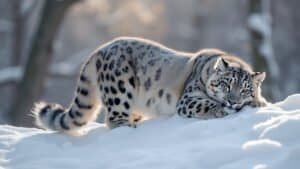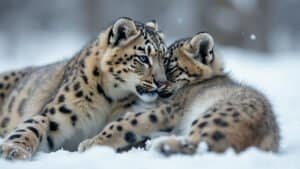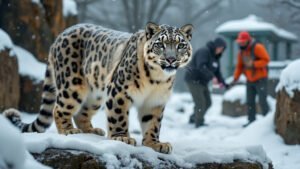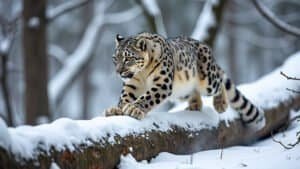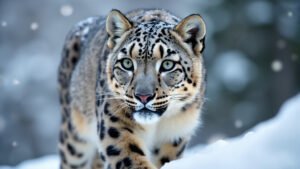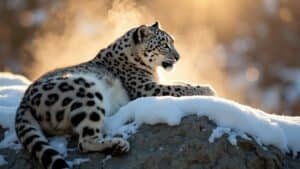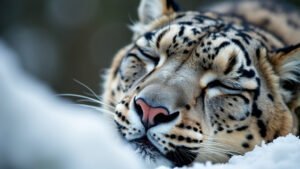Introduction
The World Wildlife Fund (WWF) plays a critical role in conserving snow leopards, one of the most elusive and endangered big cats. Through a combination of targeted programs, community engagement, and innovative technologies, WWF works tirelessly to protect these majestic animals and their habitats
This article explores the various ways WWF supports snow leopard conservation, including research initiatives, habitat protection, anti-poaching efforts, and community-based projects. By understanding the comprehensive approach taken by WWF, we can appreciate the impact of their work and the importance of continued support for snow leopard conservation efforts
WWF’s Snow Leopard Conservation Programs
WWF’s approach to snow leopard conservation is multi-faceted, addressing both direct and indirect threats to these magnificent creatures. The organization works on several fronts to ensure a sustainable future for snow leopards, including research, habitat protection, and anti-poaching efforts
Research Initiatives
Research is the cornerstone of WWF’s snow leopard conservation strategy. By understanding the behavior, ecology, and population dynamics of snow leopards, WWF can develop effective conservation strategies
One key aspect of this research involves the use of camera traps and GPS collars to monitor snow leopard movements and population sizes. These technologies provide valuable data that inform conservation efforts
In 2016, WWF collaborated with the Snow Leopard Trust and the Snow Leopard Conservancy to conduct the first comprehensive survey of snow leopard populations across the species’ range. This survey revealed critical insights into snow leopard distribution and population trends, highlighting areas where conservation efforts are most needed
Habitat Protection
Habitat protection is crucial for the survival of snow leopards. WWF works to preserve and restore the mountainous ecosystems that snow leopards call home. This involves creating and managing protected areas, promoting sustainable land use practices, and working with local communities to reduce human-wildlife conflict
One significant achievement in this area is the establishment of transboundary protected areas. For instance, WWF played a pivotal role in the creation of the Altai-Sayan Ecoregion, which spans Russia, Mongolia, Kazakhstan, and China. This region is one of the most important habitats for snow leopards, and its protection is vital for the species’ survival
Anti-Poaching Efforts
Poaching poses a significant threat to snow leopards, driven by the illegal wildlife trade and retaliatory killings by herders. WWF combats poaching through a combination of enforcement and community engagement. By working with local law enforcement agencies, WWF helps to strengthen anti-poaching laws and improve the capacity to enforce them
In addition, WWF engages with local communities to address the root causes of poaching. This includes providing alternative livelihoods for herders and educating communities about the importance of snow leopard conservation
For example, WWF has supported the establishment of community-based livestock insurance programs, which compensate herders for livestock losses caused by snow leopards, thereby reducing the incentive for retaliatory killings
WWF also employs innovative technologies to combat poaching. The use of SMART (Spatial Monitoring and Reporting Tool) allows for better tracking and reporting of illegal activities in snow leopard habitats. This tool has been implemented in several key snow leopard range countries, enhancing the effectiveness of anti-poaching efforts
Community Engagement and Education
WWF recognizes that local communities play a crucial role in the conservation of snow leopards. By working closely with these communities, WWF ensures that conservation efforts are sustainable and effective
Community engagement and education initiatives are designed to empower local people, promote coexistence with wildlife, and build a strong foundation for long-term conservation success
Working with Local Communities
WWF’s community-based conservation projects involve direct collaboration with local people living in snow leopard habitats. These projects aim to address human-wildlife conflict, improve livelihoods, and create incentives for conservation
For example, WWF supports herder communities in implementing predator-proof corrals, which help protect livestock from snow leopard attacks. This reduces the financial losses faced by herders and decreases the likelihood of retaliatory killings
In addition, WWF works with communities to develop eco-tourism initiatives that provide alternative sources of income. These initiatives not only benefit local economies but also raise awareness about snow leopard conservation. Visitors to these areas gain a deeper understanding of the challenges faced by snow leopards and the importance of preserving their habitats
Educational Programs
Education is a powerful tool for promoting snow leopard conservation. WWF conducts educational programs aimed at raising awareness among both adults and children about the importance of snow leopards and the threats they face
These programs often include workshops, school visits, and community events that highlight the ecological significance of snow leopards and the need for their protection
One successful educational initiative is WWF’s “Wildlife Champions” program, which trains local youth to become advocates for wildlife conservation. These young champions engage their communities in conservation activities, spreading knowledge and fostering a culture of stewardship for the environment
Community-Based Conservation Projects
WWF’s community-based conservation projects are designed to be inclusive and participatory, ensuring that local people have a stake in the success of conservation efforts
These projects often involve the establishment of community conservation committees, which are responsible for managing and monitoring conservation activities. By empowering local communities to take an active role in conservation, WWF ensures that these efforts are more effective and sustainable
A notable example of this approach is the establishment of the Sarychat-Ertash State Nature Reserve in Kyrgyzstan
WWF worked with local communities to create this protected area, which serves as a critical habitat for snow leopards. The reserve is managed by local people, who are trained and supported by WWF to conduct monitoring and enforcement activities
In addition to creating protected areas, WWF supports community-led initiatives to restore degraded habitats. This involves activities such as reforestation, soil erosion control, and sustainable grazing practices. By improving the quality of snow leopard habitats, these initiatives help to ensure the long-term survival of the species
Partnerships and Collaborations
WWF’s partnerships and collaborations enhance the effectiveness and reach of its snow leopard conservation programs. These alliances bring together diverse stakeholders, each contributing unique strengths and resources to the collective goal of conserving snow leopards
Government Partnerships
Working with governments is crucial for establishing and enforcing policies that protect snow leopards and their habitats
WWF collaborates with national and local governments in snow leopard range countries to develop and implement conservation strategies. These partnerships often involve creating protected areas, improving law enforcement, and integrating snow leopard conservation into national biodiversity action plans
For example, in Nepal, WWF has worked closely with the government to establish the Snow Leopard Conservation Action Plan. This plan outlines specific actions to be taken over a five-year period to protect snow leopards and their habitats. WWF’s collaboration with the Nepalese government has led to significant progress in monitoring and protecting snow leopard populations in the country
NGO Collaborations
WWF partners with other non-governmental organizations (NGOs) to strengthen snow leopard conservation efforts
These collaborations enable the sharing of knowledge, expertise, and resources, leading to more effective and comprehensive conservation programs. By working together, NGOs can tackle the multifaceted challenges facing snow leopards more efficiently
One notable collaboration is the Global Snow Leopard & Ecosystem Protection Program (GSLEP), which brings together governments, NGOs, and conservationists from across the snow leopard’s range. WWF is a key partner in this initiative, contributing to efforts to secure 20 snow leopard landscapes by 2020
Through GSLEP, WWF and its partners have implemented joint research projects, conducted conservation workshops, and developed community-based conservation programs
International Alliances
International alliances play a significant role in snow leopard conservation by facilitating cross-border cooperation and the sharing of best practices
Snow leopards often inhabit areas that span multiple countries, making international collaboration essential for their conservation. WWF works with international organizations to promote policies and practices that benefit snow leopards on a global scale
The Snow Leopard Network is an example of an international alliance that brings together researchers, conservationists, and organizations dedicated to snow leopard conservation
WWF is an active member of this network, participating in research initiatives, conservation planning, and policy advocacy. By engaging in international alliances, WWF helps to ensure a coordinated and effective approach to snow leopard conservation across their entire range
WWF also collaborates with international financial institutions to secure funding for large-scale conservation projects. For instance, the World Bank and the Global Environment Facility (GEF) have provided significant financial support for snow leopard conservation initiatives. These funds are used to implement habitat protection projects, conduct research, and support community-based conservation programs
Technology and Monitoring
Incorporating technology into conservation strategies allows WWF to enhance the effectiveness of its snow leopard conservation programs. From camera traps to GPS tracking, these technological tools provide critical insights into the lives of snow leopards and help address the challenges they face
Use of Camera Traps
Camera traps are one of the most important tools in snow leopard research and monitoring. These motion-activated cameras are strategically placed in snow leopard habitats to capture images and videos of these elusive animals. The data collected from camera traps provide valuable information on snow leopard populations, behavior, and movements
WWF has deployed camera traps across various snow leopard range countries, including India, Nepal, and Mongolia. These camera traps have captured rare and candid footage of snow leopards, contributing to a better understanding of their ecology
For example, in a groundbreaking study conducted in 2015, WWF used camera traps to estimate the snow leopard population in the Annapurna Conservation Area of Nepal. The study revealed a higher-than-expected population density, highlighting the success of conservation efforts in the region
GPS Tracking
GPS tracking technology enables WWF to monitor the movements and range of individual snow leopards. By fitting snow leopards with GPS collars, researchers can track their location in real-time and gather data on their home ranges, travel patterns, and habitat use. This information is crucial for identifying critical habitats and corridors that need protection
One notable example of GPS tracking in action is the Long-Term Ecological Study of the Snow Leopard in Mongolia
This ongoing project, initiated in 2008, involves fitting snow leopards with GPS collars to study their movements and behavior. The data collected from this study has provided insights into snow leopard territory sizes, prey preferences, and interactions with human activities
Data Analysis
The vast amount of data collected from camera traps, GPS collars, and other monitoring tools requires thorough analysis to inform conservation strategies. WWF employs advanced data analysis techniques to process and interpret this information. By analyzing data on snow leopard populations, movements, and threats, WWF can develop targeted conservation actions and measure their effectiveness
For instance, WWF uses population modeling to estimate snow leopard numbers and assess population trends over time. These models incorporate data from multiple sources, including camera traps, GPS tracking, and field surveys. The results help WWF identify population hotspots and prioritize areas for conservation interventions
WWF also uses Geographic Information Systems (GIS) to map snow leopard habitats and assess habitat connectivity. GIS technology allows researchers to visualize and analyze spatial data, such as terrain, vegetation, and human land use. This helps WWF identify critical habitats, potential wildlife corridors, and areas at risk of habitat fragmentation
Combatting Poaching with Technology
Technological innovations have significantly improved WWF’s ability to combat poaching and illegal wildlife trade
One such tool is the Spatial Monitoring and Reporting Tool (SMART), which WWF uses to enhance anti-poaching efforts. SMART is a software platform that allows rangers to collect, analyze, and report data on illegal activities, such as poaching and habitat destruction
By using SMART, WWF and its partners can monitor poaching hotspots, track patrol efforts, and assess the effectiveness of anti-poaching measures. The tool also facilitates real-time communication and coordination among rangers, improving the overall efficiency of law enforcement activities
Another technological advancement in anti-poaching efforts is the use of drones. WWF employs drones equipped with cameras and thermal imaging technology to conduct aerial surveys and monitor remote areas. Drones provide a cost-effective and efficient way to detect illegal activities and gather intelligence on poaching operations
Funding and Future Plans
Effective snow leopard conservation relies on secure funding and forward-thinking strategies. WWF works diligently to obtain the necessary financial resources and develop comprehensive plans to ensure the long-term success of its snow leopard conservation initiatives
Funding Snow Leopard Conservation
Funding is a critical component of WWF’s conservation efforts. WWF secures funding from a variety of sources, including government grants, private donations, corporate partnerships, and international financial institutions. These funds support a wide range of activities, from research and monitoring to community engagement and anti-poaching efforts
One of the primary sources of funding for WWF’s snow leopard conservation is international grants
Organizations such as the Global Environment Facility (GEF) and the World Bank provide significant financial support for large-scale conservation projects. These grants are often used to implement comprehensive conservation programs that address multiple threats to snow leopards and their habitats
Private donations also play a vital role in funding WWF’s work. Through targeted fundraising campaigns and appeals, WWF engages individual donors who are passionate about wildlife conservation. These donations help finance critical on-the-ground activities, such as the deployment of camera traps, the fitting of GPS collars, and the implementation of community-based conservation projects
Corporate partnerships provide another important source of funding. WWF collaborates with businesses that are committed to sustainability and wildlife conservation
These partnerships often involve financial contributions, as well as in-kind support and joint initiatives. For example, WWF’s partnership with the Swedish outdoor company Fjällräven includes funding for snow leopard research and conservation activities in Central Asia
Strategic Planning
WWF’s strategic planning for snow leopard conservation involves setting clear goals, identifying priorities, and developing detailed action plans
These plans are designed to be adaptive and responsive to new information and changing circumstances. WWF regularly reviews and updates its strategies to ensure they remain effective and relevant
The Global Snow Leopard and Ecosystem Protection Plan (GSLEP) is a key component of WWF’s strategic planning. Developed in collaboration with snow leopard range countries and other conservation organizations, GSLEP outlines a comprehensive framework for snow leopard conservation. The plan includes specific targets, such as securing 20 snow leopard landscapes by 2020, and provides a roadmap for achieving these goals
WWF’s strategic planning also emphasizes the importance of building local capacity. By training and supporting local conservationists, WWF ensures that snow leopard conservation efforts are sustainable and locally driven. This approach helps to create a strong foundation for long-term conservation success
Future Conservation Goals
Looking ahead, WWF has set ambitious goals for snow leopard conservation. One of the primary objectives is to secure and connect key snow leopard habitats
This involves creating new protected areas, expanding existing ones, and establishing wildlife corridors that allow snow leopards to move freely across their range. By ensuring habitat connectivity, WWF aims to support healthy, viable populations of snow leopards
WWF also plans to enhance its use of technology in conservation efforts. This includes expanding the use of camera traps and GPS collars, as well as incorporating new tools such as drones and satellite imagery. These technologies will provide more accurate and comprehensive data on snow leopard populations and threats, enabling more effective conservation actions
Another future goal is to strengthen community engagement and education programs. WWF aims to increase the involvement of local communities in conservation efforts, promoting a sense of ownership and responsibility for snow leopard conservation. By empowering communities, WWF hopes to create lasting conservation outcomes that benefit both people and wildlife
Finally, WWF is committed to addressing the root causes of threats to snow leopards. This includes tackling issues such as human-wildlife conflict, habitat loss, and climate change. WWF plans to implement integrated conservation approaches that address these underlying challenges, ensuring a holistic and sustainable approach to snow leopard conservation
Conclusion
WWF’s comprehensive approach to snow leopard conservation encompasses research initiatives, habitat protection, anti-poaching efforts, community engagement, strategic partnerships, and the use of advanced technology. By collaborating with local communities, governments, NGOs, and international organizations, WWF has made significant strides in safeguarding snow leopards and their habitats
Funding and strategic planning play crucial roles in ensuring the sustainability of these efforts, while future goals focus on enhancing habitat connectivity, expanding technological use, and addressing the root causes of threats to snow leopards. Continued support for WWF’s initiatives is vital for the long-term survival of this iconic species



